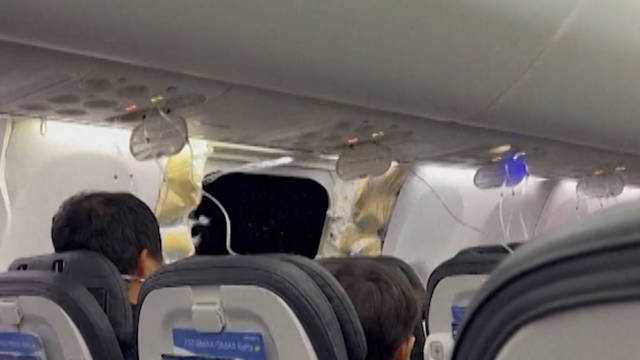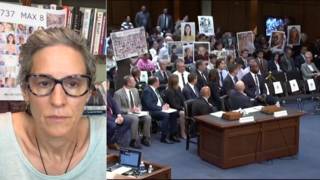
By Amy Goodman & Denis Moynihan
If you’re flying on a Boeing, buckle up.
Passengers aboard Alaska Airlines flight 1282 on Friday, January 5th were lucky their seat belts were snug when an entire side panel blew out, leaving a gaping hole in the fuselage as the plane passed 16,000 feet after taking off from Portland, Oregon. The rapid cabin depressurization tore the shirt off a teenaged passenger and several others were injured. Miraculously, no one was killed, and the pilots landed safely. This Boeing 737 MAX 9 was almost brand new, but had already triggered three separate cabin pressurization warnings. Alaska Airlines decided to restrict the plane to shorter flights, and not over water. If history is any guide, the answer to why the panel blew out may be simple: Boeing’s long history of thwarting regulation, cutting corners, and corporate crime.
Renowned consumer advocate Ralph Nader knows painfully well about Boeing’s negligence. On March 10th, 2019, his grandniece, Samya Rose Stumo, boarded Ethiopian Airlines flight 302. The Boeing 737 MAX 8 was only four months old. Minutes after takeoff, the plane nosedived and crashed, killing all 157 people on board. This was the second fatal crash of a Boeing 737 Max 8, following the October 29, 2018 crash of Lion Air Flight 610 in Indonesia, that claimed the lives of all 189 passengers and crew on board.
“Samya was extraordinary. She was an emerging leader in global health in her early twenties,” Nader said on the Democracy Now! news hour, coincidentally, just hours before the Boeing Max 9 blowout on the Alaska Airlines flight occurred. “It was a huge loss…due to Boeing’s criminal design of the Boeing 737 MAX.”
Immediately after the flight 302 crash in 2019, Samya’s mother, Nadia Milleron, anguished, raced with family members to the scene, seeking answers. Since then, Nadia has become a tireless advocate for airline safety, and for holding Boeing accountable.
“There are serious, serious problems with these MAX planes, and they have caused near accidents on repeated occasions,” Milleron said on Democracy Now!, after the Alaska Airlines incident. Nadia explained one method Boeing recently used to skirt federal oversight:
“Boeing is trying to evade safety regulations. In December of 2022, they went to Congress, because the FAA wouldn’t — all the safety regulations are written in blood. All of them are there because people have died. Regulation is in response to the death and trying to prevent more deaths. So, Boeing went to Congress and, through the military authorization act, they got another exemption for themselves.”
Boeing introduced the 737 commercial airliner in 1967 – more than half a century ago – and it quickly became a workhorse of passenger aviation. Boeing rushed the updated 737 Max series – the Max 7, 8, 9 and 10 – to compete with Airbus, the European consortium, which released its own updated Airbus 320 with remarkable success.
“Everything was being rushed,” Ed Pierson recalled on Democracy Now! He is executive director of the Foundation for Aviation Safety and a former senior manager at Boeing, who was at Boeing when the Max 8 was in production. “We had a shortage of skilled employees. We were having all kinds of issues with quality problems. There was just incredible schedule pressure. There’s a saying in the factory: They call it ‘schedule is king.’ As we were going through those types of issues, myself and others verbalized our concerns, and we did our best to try to stop the production system at that point. Unfortunately, we were, sadly, unable to do that.”
In response to the two fatal crashes in 2018 and 2019, Ed retired from Boeing and launched the Foundation for Aviation Safety, to hold to account the industry and its all-too-often captured regulators.
“This incident with Alaska, I’m sure, is shocking to passengers, but for those of us who have been watching this for a while, it’s really not a surprise at all,” Ed continued. “We’ve seen, ever since the MAX has been put back in service, over 20 serious production quality defects that have surfaced…and the public is unaware.”
The panel that blew out of Alaska Airlines flight 1282 was supposed to be held in place by four bolts. United Airlines reported it found loose bolts as it inspected its grounded 737 Max 9s. But even if every bolt is tightened to specification, that’s just , as Ed Pierson says, “a tip of the iceberg.”
Boeing was criminally charged in the wake of the two 737 Max 8 crashes, but negotiated a “deferred prosecution agreement” with the Justice Department, which Nadia Milleron says is illegal, as victims weren’t consulted.
Corporations that cut corners to increase profit, putting lives at risk, must be held to the same standards as anyone who harms another. Violators like Boeing need to be prosecuted, to show without a doubt that corporate crime doesn’t pay.












Media Options